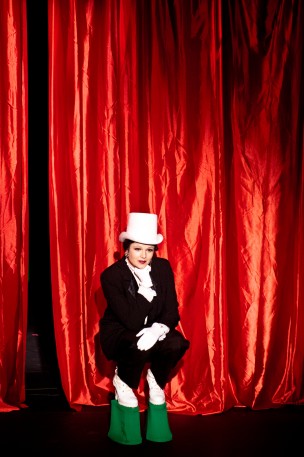
Andrew Ribner/Visual Editor
A glowing red curtain draped across the stage greeted theatergoers at the CFA Theater last Saturday night, recalling the drapes used by movie theaters of the Golden Age.
The promise implied by that curtain did not disappoint: “Liebe Love Amour!,” a piece by Anonymous Ensemble playing that night, was both an homage to and a burlesque of those Golden Age ideals (particularly love, of course). But if you thought you could sit back, relax, and enjoy the show from the safety of your seat, you were in for a disappointment.
Before the performance proper commenced, Anonymous Ensemble actors Eamonn Farrell and Liz Davito could be seen wandering the audience with their fellow performer and set designer Joseph Lark-Riley. Completely comfortable, they had no qualms about approaching audience members to offer assistance or talking to students who had been involved in their workshop Thursday evening. True to theatrical tradition, when the show started they disappeared behind the curtain to the stage, but this was but a temporary reprieve for audience members uncomfortable with up-close-and-personal performances.
Nearly as much a filmic project as a theatrical one, “Liebe Love Amour!” began with a series of vintage film clips of a wedding by Erich Oswald Stroheim, a Viennese filmmaker whose work in the early twentieth century frequently focused on “pure love.” Not long into the piece, though, his films were replaced by a dramatic close-up of the shivering face of Jessica Weinstein ’02, a lost bride shivering under her veil. Just as jarring as the shift in cinematography was our sudden double vision: Weinstein appeared not only on the huge panel the film clips were projected onto but also in a ghostly, hazy vision on the stage itself, visible through the now-translucent red curtain.
Weinstein is unambiguously the star of this piece—or at least, her character, Tall Hilda, is. Hilda has apparently appeared in a number of earlier Anonymous pieces, such as “The Best” and “Wanderlust,” and the program notes treat her more like a second persona than a dramatic character. This particular play chronicles Hilda’s search for love in the guise of a Golden Age film actress, doomed never to find love if she fails to marry by her 33rd year. Before our eyes, through the magic of video streaming and an onstage green screen, Hilda dances, sings, and collapses into a tantrum in her (onscreen) dressing room. Davito and Farrell do an exquisite job voicing every other character in the show, from the wisecracking dressing room neighbors to Hilda’s parents, lovers, and friends.
The performance really took off, though, when the audience got almost literally sucked into it. Early in the performance, Hilda asked the audience questions about love; what spice their heart is, for example. Lark-Riley, the man in the green jumpsuit and coat who provided a number of hilarious and ingenious green screen effects, roamed the audience with a microphone and, finding a volunteer, also found an answer: “Cumin.”
“Wonderful,” gasped Hilda.
The production would hardly be noteworthy, though, if the audience merely provided Mad-Libs-style answers to questions engineered for laughs. As Hilda began telling her story to an old ventriloquist’s dummy (Otto, who is apparently an incredible listener), the audience became a part of the narrative: one girl took on the role of Hilda’s childhood friend, explaining how her parents met. Later volunteers were even pulled onto the stage, handed a microphone, and filmed live in front of the green screen, taking on parts as Hilda’s old friends, new acquaintances, and old flames. Although it took a while for the crowd to warm up to this idea, the results were often funny and sometimes surprisingly beautiful.
The company describes “Liebe Love Amour!” as a “love affair with an audience,” and it is certainly a whole-hearted attempt at such an event (up to and including a “marriage” between Hilda and, well, everyone). The blurring of boundaries encourages this panphilism: the boundary between film and theater, between male and female (Hilda clearly sees herself as not terribly feminine, given her height and her childhood nickname, “the cross-eyed girl”), and between the actors in the house of the theater and the audience pulled onto its stage. And the pseudo-Brechtian nature of its execution—the green screen visible, if only just, the constant winking of the actors at the conventions of the movies they are utilizing for their now almost grotesque and exaggerated style, the spontaneous audience responses that sometimes almost break the performance (or might, were it not for the cast’s excellent improvisatory skills)—does a good job spurring us to consider the perils and pitfalls of love, whether it be romantic, social, or even universal.
1 Comment
Captain von Rauffenstein
i think the main inspiration for the performance should be cited by his stage name “Erich von Stroheim” and not his birth name.